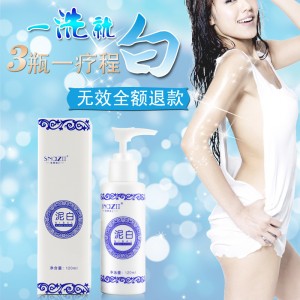
Chinese cosmetics have become increasingly prevalent in Chinese culture resulting in a highly competitive market. In her article, “In China’s Cosmetics Market Beauty is Pocket Deep,” Jill Petzinger explains that Western brands have struggled to dominate the market while local brands have succeeded in gaining tremendous popularity. Therefore, brands must cater to the fickle local tastes in the region in order to flourish. While adhering to local consumers, the advertisement above exposes a product that is exceedingly popular among Chinese females and highlights a prominent aspect of Chinese beauty: skin whitener. [focal point]
Local Brand: Upon viewing this image, we can immediately see the Chinese symbols written both on the advertisement and the whitening product itself. Pitzinger explains that products by L’Oreal, for example, reject animal testing procedures which is has had an impact on their struggle for business. Chinese consumers pay more attention to the brand, the product and its price, rather than animal testing ideals. Local brands such as Chinese Herborist, for example, uses traditional Chinese ingredients in its products which intentionally target Chinese consumers. Consumers can not only receive the benefits from the products, but can experience satisfaction of investing in a product that has cultural traditional meaning and value. Cindy Yang, Senior Director or Nielsen China says, “local brands are more flexible and faster in execution…they have leveraged traditional Asian ingredients well and made their products very convincing,” in comparison to Western brands. In addition, Eastern brands are more specialized in skin whitening, Pitzinger explains.
stay with the focal claim, skin whitener
Skin Whitener: There is significant attention and emphasis placed on skin health and color among Chinese women. The female portrayed in this advertisement has very light skin, not only on her face, but on her entire body. We can see her skin glistening and certain areas such as her arm are shined substantially to create a more dramatic effect. In contrast with Western customs and skincare preferences, Chinese women explore ways to increase skin whiteness. As discussed in class, this preference began years ago when Chinese people with darker skin were assumed peasants because darker tones were associated with work under the sun. Therefore, skin whiteness was associated with non-workers and an indicator of high class and elite status. Pitzinger writes about Chinese consumers: “they look for the best products to lighten the skin and provide luminosity.”
address further the question of why whitening the skin
Sexualization of the female body: The female in this image is portrayed in a very sexualized manner. She is wearing a white, loose, and revealing tank top that exposes much of her body. She attracts consumers by flashing her white, smooth, and illuminated skin. The advertiser made a concerted effort to create a cool, clean, and shiny image to cater to consumers’ ideals using blue and white colors. The focus is on the female’s skin and in order to achieve this, the advertiser cut off some of the female’s head, hiding much of her hair so as not to interfere and become a distraction. The sexualized female is appealing to other female consumers because her image adheres to the notion that they, too, could look like her by using the product.
female sexuality in terms of white skin?
